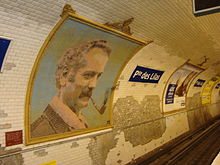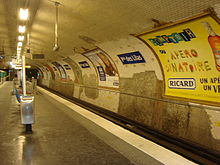Porte des Lilas (Paris Métro)
|
|
|
|---|---|

|
|
| Tariff zone | 1 |
| Line (s) |
|
| place | Paris XIX , XX |
| opening | November 27, 1921 |


Porte des Lilas is an underground transfer station of the Paris Métro . It is served by lines 3 to and 11 . There is a tram stop for the T3b tram in the immediate vicinity .
location
The metro station is located on the border of the Quartier d'Amérique in the 19th arrondissement with the Quartier Saint-Fargeau in the 20th arrondissement of Paris . It lies under the east end of Rue de Belleville and consists of three independent stations, one of which is currently closed.
Surname
The eponymous gate Porte des Lilas led into the municipality of Les Lilas , which emerged in 1867 from the division of the municipality of Romainville. It got its name from the lilac bushes (fr: lilas) of the nearby gardens that existed there from the time of the Second Empire until the 20th century.
history
Two of the stations went into operation on November 27, 1921 with the opening of line 3 . Its station A, which is still in use, is in front of an end loop and is currently served by line 3 to . Station B was intended for joint traffic with line 7 (since 1967: 7 bis ), which was connected via the Voie navette and Voie des Fêtes routes. However, there was no continuous traffic between these lines, instead a shuttle train (fr: navette) ran over the Voie navette to the Pré-Saint-Gervais station . In the course of mobilization at the beginning of the Second World War , this type of operation was given up on September 3, 1939, and station B has been closed to passengers since then. At the beginning of the 1950s, the Voie navette with Station B was used to test the rubber-tyred prototype vehicle MP 51 . Station B was repeatedly used for filming and is therefore also known as the “ Porte des Lilas - Cinéma ”.
In 1922, an above-ground access structure was built at the confluence of Avenue Gambetta, the architect was Charles Plumet .
The Porte des Lilas station on line 11 opened on April 28, 1935. Until February 17, 1937 it was the end point of this line. On March 27, 1971, line 3 was continued from Gambetta to Gallieni and the previous end section between Gambetta and Porte des Lilas became independent line 3 bis .
description
From the southeast, the route of line 3 shares until shortly before the station in the branches to the stations A and B of the disused station B currently is only the western route railway, which leads into the track towards Gambetta. The Voie navette track in the opposite direction begins bluntly south of station B and can be reached via a simple change of track .
There are also simple track changes on both sides of Station A, the south of which allows trains to head off without having to go through the double-track turning loop. The latter connects to the north of the station, and an operating track branches off the outer track to the Voie navette.
All three stations were built by mining and are 75 m long. They lie under elliptical vaults, their white tiled side walls follow the curvature of the ellipse. Stations A and B have side platforms on two parallel tracks, the three-track station of line 11 has a side and a central platform in two separate halls. By Parisian standards, stations A and B are 19 to 25 meters below the surface, very deep. This is due to their profile and made the construction of elevators necessary. Because of this depth, the station on line 11 could be built above the existing facilities.
vehicles
In 1967, line 3 was the first in the Métro network to receive vehicles from the MF 67 series . In contrast to the other routes as a 3-car train, this series is still on the short line 3 bis .
Line 11 was prepared for trains with rubber tires from 1954. In November 1956, the MP 55 series was used, initially for almost a year in mixed traffic with conventional Sprague-Thomson trains . The MP 59 series has been running on line 11 since January 1999 .
The shuttle service to the Pré-Saint-Gervais station, also known as line 3 ter , was carried out with a single short train. This was initially made up of two 10.85 meter long Sprague multiple railcars that had previously run on line 2 . In 1926, a new, individually running Sprague-Thomson multiple unit of the M 1005-1022 series (“Petite loge” type) with driver's cabs at both ends of the vehicle came onto the line.
outlook
For the period after 2030 it is planned to unite lines 3 to and 7 to , whereby station B would be reactivated for passenger traffic.
Others
- The chanson Le poinçonneur des Lilas by Serge Gainsbourg from 1958 about the monotonous work of validating countless tickets described the station as a place of alienated work for an employee of the Métro.
- Scenes from the film Die Nacht ist Jung (Fr: Mauvais sang ) by Leos Carax were shot in 1986 in Station B.
- Station B can also be seen in the films The fabulous world of Amélie and Super-Hypochondriacs (each as Station Abbesses ) as well as Paris, je t'aime (station name: Tuileries ), Female Agents - Phoenix Secret Command (as Concorde ), recruits of death (as Montparnasse ), Point Blank - From a short distance (as Opéra ) and 3 Days to Kill (as Station Ségur ).
Remarks
- ↑ 3 bis , also 3 bis or 3bis, corresponds to the German 3a, 3 ter to the German 3b
- ↑ In the course of testing the MP 51 , passenger service was resumed from April 1952 to May 1956 - every day in the afternoon between 1.30 p.m. and 7.30 p.m.
Web links
literature
- Gérard Roland: Stations de métro. D'Abbesses à Wagram . 2003, ISBN 2-86253-307-6 .
Individual evidence
- ^ A b Gérard Roland: Stations de métro d'Abbesses à Wagram . Christine Bonneton, Clermont-Ferrand 2011, ISBN 978-2-86253-382-7 , pp. 174 .
- ^ Jean Tricoire: Un siècle de métro en 14 lignes. De Bienvenüe à Météor . 2nd Edition. La Vie du Rail, Paris 2000, ISBN 2-902808-87-9 , p. 226 .
- ↑ a b Jean Tricoire, op. Cit. P. 166.
- ↑ Jean Tricoire, op. Cit. P. 167.
- ↑ Mark Ovenden: Paris Underground . Penguin Books, London 2009, ISBN 978-0-14-311639-4 , pp. 72 .
- ↑ Mark Ovenden, op. Cit. P. 47.
- ↑ Jean Tricoire, op. Cit. P. 284.
- ↑ Jean Tricoire, op. Cit. P. 168.
- ^ Brian Hardy: Paris Metro Handbook . 3. Edition. Capital Transport Publishing, Harrow Weald 1999, ISBN 1-85414-212-7 , pp. 36 .
- ↑ Jean Tricoire, op. Cit. P. 286.
- ↑ Jean Tricoire, op. Cit. P. 282.
- ↑ Jean Tricoire, op. Cit. P. 90.
- ↑ Fusion des lignes 3 bis et 7 bis du métro de Paris at viadeo.com, accessed on April 24, 2016.
- ^ Julian Pepinster: Le métro de Paris . Éditions La Vie du Rail, Paris 2010, ISBN 978-2-918758-12-9 , p. 249 .
| Previous station | Paris metro | Next station |
|---|---|---|
|
Saint-Fargeau ← Gambetta |
|
final destination |
|
Télégraphe ← Châtelet |
|
Mairie des Lilas Mairie des Lilas → |
Coordinates: 48 ° 52 ′ 37.7 " N , 2 ° 24 ′ 23.1" E



